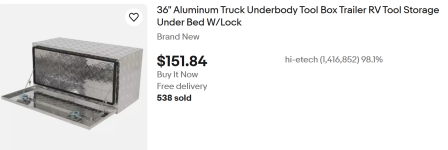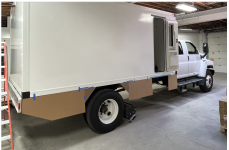You are using an out of date browser. It may not display this or other websites correctly.
You should upgrade or use an alternative browser.
You should upgrade or use an alternative browser.
Isuzu npr 4wd
- Thread starter gator70
- Start date
Ferjablito
Active member
They look like they are custom-made.
They look like they are custom-made.
Beautiful work - can't afford them

Ute Tray & Flatbed Tool Boxes - Summit Expedition Trucks - SET Overland Ltd.
With our modular system, tool boxes can be attached at any point. We have many standard sizes available to fit both our products and third party.
 setoverland.com
setoverland.com
Maybe I need to buy these and modify them

Last edited:
rruff
Explorer
Good luck...Maybe I need to buy these and modify them
Good luck...
I have a aluminum sheet fabricator and welder
So far I had a lot of luck buying new items and repurposing them.
Cost dropped 75% - without some shoudy work as a result
SkiFreak
Crazy Person
Normally, if you fabricate something from scratch you get exactly what you want.
Modifying an existing product can be beneficial sometimes, but more often than not, it will take longer and it may end up being a compromise for what you actually want.
Determining which is the best way to go is the challenge.
If you make the wrong choice, ultimately it will cost more time and money. Ask me how I know...
Modifying an existing product can be beneficial sometimes, but more often than not, it will take longer and it may end up being a compromise for what you actually want.
Determining which is the best way to go is the challenge.
If you make the wrong choice, ultimately it will cost more time and money. Ask me how I know...
Trying to get this tank installation correct. Can anyone comment??
+++++
Yes — with a transfer pump setup, it's common and safe to route the fuel line from the auxiliary tank’s pump into the main tank’s fill neck using a fill neck adapter.
+++++
Example

+++++
 Can I Route the Fuel Line from the Transfer Pump into the Main Tank’s Fill Neck?
Can I Route the Fuel Line from the Transfer Pump into the Main Tank’s Fill Neck?
Yes — with a transfer pump setup, it's common and safe to route the fuel line from the auxiliary tank’s pump into the main tank’s fill neck using a fill neck adapter.
 How It Works
How It Works

- Fuel flows from the auxiliary tank through the transfer pump.
- The pump pushes fuel into a fill neck adapter installed on the main tank’s fill tube.
- The fuel then enters the main tank just as if you were filling it with a gas station nozzle.
 What You’ll Need
What You’ll Need

- Transfer Pump
- Mounted to the auxiliary tank or inline
- 12V powered, typically wired to a cab switch
- Fuel Hose (fuel-rated)
- Connect from the pump outlet to the fill neck adapter
- Fill Neck Adapter
- Installs between the fuel cap and the fill tube
- Designed for pump-fed auxiliary systems
- Clamps & Fittings
- All connections should be secure and leak-free
 Installation Summary
Installation Summary

- Mount the transfer pump on the auxiliary tank outlet.
- Run the fuel hose from the pump outlet to the fill neck adapter.
- Install the fill neck adapter on the main tank’s fill tube.
- Wire the pump to a toggle switch or timer in the cab.
- Secure all fittings, check for leaks, and test the system.
 Important Notes
Important Notes

- Never run the transfer pump unattended. Only activate it when the vehicle is consuming fuel to avoid overfilling.
- Use a check valve if needed to prevent backflow or fumes from entering the auxiliary tank.
+++++
Example

SkiFreak
Crazy Person
What do you want comments about?Trying to get this tank installation correct. Can anyone comment??
Ask specific questions if you want other people's opinions.
One comment I would make immediately is that if the image above is your goal, be prepared to wait a very long time for any fuel transfer being done through a 3/8" fuel line.
My fuel transfer pump has a flow rate of about 20L/min with 3/4" lines, which is okay, but it's still not fast.
What do you want comments about?
Ask specific questions if you want other people's opinions.
One comment I would make immediately is that if the image above is your goal, be prepared to wait a very long time for any fuel transfer being done through a 3/8" fuel line.
My fuel transfer pump has a flow rate of about 20L/min with 3/4" lines, which is okay, but it's still not fast.
Thanks, I did get the comments I was looking for
I guess, it is time to make and eat a sandwich, and listen to a few songs.
SkiFreak
Crazy Person
In my truck I have a custom built, micro-controller based fuel transfer system, which I designed and manufactured myself.
The system includes a single momentary button and a tri-colour status LED to control fuel flow from my 110L reserve tank to my primary 200L main tank.
The design includes safety features, so that it is not possible to pump fuel from the reserve tank if there is insufficient space in the main tank. If the main tank runs out of space while transferring fuel, the transfer pump will automatically be turned off. When the reserve tank is empty, the transfer pump will also turn off automatically.
The transfer pump is started and stopped by a single press of the 25mm, stainless steel momentary button. The LED clearly indicated the state of the system and reports errors, should they occur, like trying to run the transfer pump if the main tank is full.
Another feature of my fuel transfer system is that when not in use, it draws no current whatsoever, so it does not contribute to parasitic loads on the batteries.
The system includes a single momentary button and a tri-colour status LED to control fuel flow from my 110L reserve tank to my primary 200L main tank.
The design includes safety features, so that it is not possible to pump fuel from the reserve tank if there is insufficient space in the main tank. If the main tank runs out of space while transferring fuel, the transfer pump will automatically be turned off. When the reserve tank is empty, the transfer pump will also turn off automatically.
The transfer pump is started and stopped by a single press of the 25mm, stainless steel momentary button. The LED clearly indicated the state of the system and reports errors, should they occur, like trying to run the transfer pump if the main tank is full.
Another feature of my fuel transfer system is that when not in use, it draws no current whatsoever, so it does not contribute to parasitic loads on the batteries.
lanceatm
Founder and CEO of EarthCruiser
Just one more thing, petrol is classed as an explosive, diesel is considered a flammable. There is a world of difference between transporting/transferring/storing/handling in any way these two very different fluids. This is not subject for anyone other than the experts in my humble opinion. Diesel fuel is much safer easier to handle than petrol/gas for many reasons.
Besides the grave fire/explosive risk modern petrol/gas engines have very sophisticated emission control systems that work on among many things recognised pressure values, any changes to that established system will have unknown consequences, none likely to be good. Best left alone would be my advice and look for another storage solution independent of the vehicle system.
Besides the grave fire/explosive risk modern petrol/gas engines have very sophisticated emission control systems that work on among many things recognised pressure values, any changes to that established system will have unknown consequences, none likely to be good. Best left alone would be my advice and look for another storage solution independent of the vehicle system.
Peter_n_Margaret
Adventurer
In Oz, I use MDPE rotomoulded DIY tanks for diesel, legally. For Petrol they need to be cross linked HDPE which is much more difficult and expensive.
Cheers,
Peter
OKA196 motorhome
Cheers,
Peter
OKA196 motorhome
Similar threads
- Replies
- 6
- Views
- 1K
- Replies
- 7
- Views
- 943
- Replies
- 8
- Views
- 1K
- Replies
- 53
- Views
- 6K




